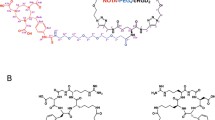Abstract
Purpose
Many patients worldwide suffer from cardiovascular diseases for which an underlying factor is thrombosis. Devising a molecular imaging technique for early detection of thrombosis in a clinical setting is highly recommended. Because fibrin is a major constituent of clots and is present in all types of thrombi but absent in circulation, it is a highly specific and sensitive target for molecular imaging of thrombi. It is assumed that cyclization of peptides will improve the receptor binding affinity and stability of the peptide. In the present study, we have developed linear and cyclic fibrin-binding peptides for thrombus imaging and compared their biological properties.
Procedures
Linear HYNIC-GPRPP and cyclic HYNIC-CGPRPPC peptides were synthesized using a standard Fmoc strategy and radiolabeled with Tc-99m. The stability of the radiolabeled peptides in human plasma and their affinity for fibrin and blood clots were determined. Blood clearance and biodistribution were evaluated in rats and mice, respectively. The peptide with the highest affinity was injected to a live rabbit femoral thrombosis model, and scintigraphic images were obtained.
Results
In vitro studies show that peptides are stable in human plasma and have a high affinity for human fibrin. They also demonstrated fast blood clearance in rats and high thrombus uptake in the Balb/c mice femoral thrombosis model. Femoral thrombosis was visualized 30 min postinjection of cyclic peptide in a live rabbit model using single photon emission computed tomography (SPECT)/X-ray computed tomography.
Conclusions
The results indicate that the cyclic peptide is a promising agent for molecular imaging of fibrin using SPECT.





Similar content being viewed by others
Abbreviations
- GPRPP:
-
Glycine proline arginine proline proline
- CGPRPPC:
-
Cysteine glycine proline arginine proline proline cysteine
- HYNIC:
-
6-Hydrazinonicotinamide
- TFA:
-
Trifluoroacetic acid
- Tricine:
-
N-[Tris(hydroxymethyl)methyl]glycine
- DIPEA:
-
Diisopropylethylamine
- DMF:
-
Dimethylformamide
- TIS:
-
Triisobutylsilane
- MEK:
-
Methyl ethyl ketone
- EDDA:
-
Ethylenediamine diacetate
- Fmoc:
-
9-Fluoroenylmethoxycarbonyl
- DCM:
-
Dichloromethane
- MeOH:
-
Methanol
- HBS:
-
HEPES-buffered saline
- DVT:
-
Deep venous thrombosis
- PE:
-
Pulmonary embolism
- TBTU:
-
O-(Benzotriazol-1-yl)-N,N,N′,N′-tetramethyluronium tetrafluoroborate
References
Starmans LWE, Van Duijnhoven SMJ, Rossin R, et al. (2013) Evaluation of 111In-labeled EPep and FibPep as tracers for fibrin SPECT imaging. Mol Pharm 10:4309–4321
Starmans LWE, van Mourik T, Rossin R, et al. (2015) Noninvasive visualization of tumoral fibrin deposition using a peptidic fibrin-binding single photon emission computed tomography tracer. Mol Pharm 12:1921–1928
Hara T, Bhayana B, Thompson B, et al. (2012) Molecular imaging of fibrin deposition in deep vein thrombosis using fibrin-targeted near-infrared fluorescence. JACC Cardiovasc Imaging 5:607–615
Chung EJ, Cheng Y, Morshed R, et al. (2014) Fibrin-binding, peptide amphiphile micelles for targeting glioblastoma. Biomaterials 35:1249–1256
Starmans LWE, van Duijnhoven SMJ, Rossin R, et al. (2012) SPECT imaging of fibrin using fibrin-binding peptides. Contrast Media Mol Imaging 8:229–237
Schaible TF, Alavi A (1991) Antifibrin scintigraphy in the diagnostic evaluation of acute deep venous thrombosis. Semin Nucl Med 21:313–324
Palabrica TM, Furie BC, Konstam MA, et al. (1989) Thrombus imaging in a primate model with antibodies specific for an external membrane protein of activated platelets. Proc Natl Acad Sci U S A 86:1036–1040
Knight LC (2001) Radiolabeled peptide ligands for imaging thrombi and emboli. Nucl Med Biol 28:515–526
Ciesienski KL, Yang Y, Ay I, Chonde DB, et al. (2013) Fibrin-targeted PET probes for the detection of thrombi. Mol Pharm 10:1100–1110
Laudano AP, Doolittle RF (1978) Synthetic peptide derivatives that bind to fibrinogen and prevent the polymerization of fibrin monomers. Proc Natl Acad Sci U S A 75:3085–3089
Kawasaki K, Tsuji T, Hirase K, et al. (1993) Amino acids and peptides. XVII. Synthesis of peptides related to N-terminal portion of fibrin alpha-chain and their inhibitory effect on fibrinogen/thrombin clotting. Chem Pharm Bull (Tokyo) 41:525–528
Thakur ML, Pallela VR, Consigny PM, et al. (2000) Imaging vascular thrombosis with 99mTc-labeled fibrin alpha-chain peptide. J Nucl Med 41:161–168
Aruva MR, Daviau J, Sharma SS, Thakur ML (2006) Imaging thromboembolism with fibrin-avid 99mTc-peptide: evaluation in swine. J Nucl Med 47:155–162
Kolodziej AF, Nair SA, Graham P, et al. (2012) Fibrin specific peptides derived by phage display: characterization of peptides and conjugates for imaging. Bioconjug Chem 23:548–556
Spuentrup E, Botnar RM, Wiethoff AJ, et al. (2008) MR imaging of thrombi using EP-2104R, a fibrin-specific contrast agent: initial results in patients. Eur Radiol 18:1995–2005
Sirol M, Fuster V, Badimon JJ, et al. (2005) Chronic thrombus detection with in vivo magnetic resonance imaging and a fibrin-targeted contrast agent. Circulation 112:1594–1600
Botnar RM, Buecker A, Wiethoff AJ, et al. (2004) In vivo magnetic resonance imaging of coronary thrombosis using a fibrin-binding molecular magnetic resonance contrast agent. Circulation 110:1463–1466
Vymazal J, Spuentrup E, Cardenas-Molina G, et al. (2009) Thrombus imaging with fibrin-specific gadolinium-based MR contrast agent EP-2104R: results of a phase II clinical study of feasibility. Investig Radiol 44:697–704
Galanis AS, Albericio F, Grøtli M (2009) Enhanced microwave-assisted method for on-bead disulfide bond formation: synthesis of alpha-conotoxin MII. Biopolymers 92:23–34
Berezhkovskiy L, Pham S, Reich EP, Deshpande S (1999) Synthesis and kinetics of cyclization of MHC class II-derived cyclic peptide vaccine for diabetes. J Pept Res 54:112–119
Khoshbakht S, Kobarfard F, Beiki D, et al. (2016) HYNIC a bifunctional prosthetic group for the labelling of peptides with 99mTc and 18FDG. J Radioanal Nucl Chem 307:1125–1134
Acknowledgments
This research was supported by Shahid Beheshti University of Medical Sciences, Tehran, Iran; grant no. 8002.
Author information
Authors and Affiliations
Corresponding author
Ethics declarations
Conflict of Interest Statement
The authors declare that they have no conflict of interest.
Electronic supplementary material
ESM 1
(PDF 271 kb)
Rights and permissions
About this article
Cite this article
Rezaeianpour, S., Bozorgi, A.H., Moghimi, A. et al. Synthesis and Biological Evaluation of Cyclic [99mTc]-HYNIC-CGPRPPC as a Fibrin-Binding Peptide for Molecular Imaging of Thrombosis and Its Comparison with [99mTc]-HYNIC-GPRPP. Mol Imaging Biol 19, 256–264 (2017). https://doi.org/10.1007/s11307-016-1004-3
Published:
Issue Date:
DOI: https://doi.org/10.1007/s11307-016-1004-3




